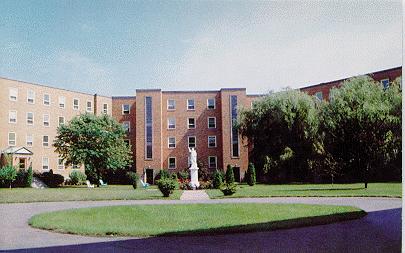 The
History of Women at St. Francis Xavier University
The
History of Women at St. Francis Xavier University The
History of Women at St. Francis Xavier University
The
History of Women at St. Francis Xavier UniversityMount Saint Bernard
As St. Bernardís Convent School grew in its student population, so did its status. In 1886, after a visit from the Superintendent of Education, St. Bernardís School qualified for government subsidies and became known as St. Bernardís Young Ladies Academy. It was to function with St. Francis Xavier Academy as a Department of the County Academy (Mount Saint Bernard Centennial 1883-1983, 19). It was also at this time that the school was expanded to include grades nine through twelve as well as one through eight (Cameron, 78)
Within six years, students began to express an interest in continuing their education, with a number of them returning for course work at the post-secondary level, being accommodated as "special" students pending arrangements for degree granting privileges. Arrangements were made by the Superior, Sister St. Maurice with Bishop Cameron, whose "Victorian beliefs" that women had a "keener sense of Christian faith and morality than men", helped him make his decision to extend opportunities in higher education to women (Cameron, 96-97). Thus in 1894, St. Bernardís Academy became affiliated with St. Francis Xavier College, thereby allowing women to obtain a Bachelor of Arts degree (Cameron, 96-97).
The year 1897 proved to be a landmark year in the higher education
of Catholic women. It was in June of this year that four young women graduated
with a Bachelor of Arts degree, thus St. Bernardís Academy, in affiliation
with St. Francis Xavier College, became the first Catholic college in North
America to grant degrees to women, a truly momentous event for women of
the Catholic faith (Cameron, 97). Prior to this, Protestant women
had been attending Protestant universities, with the first woman to graduate
from university in the British Empire, graduating from Mount Allison in
1875 with a Bachelor of Science degree (Prentice et al., 174). Women
had also been attending various other colleges and universities before
the first Catholic women graduated from Mount Saint Bernard, nevertheless,
one must not overlook

By 1894, the year of St. Bernardís affiliation with St. F.X., the curriculum evolved into three levels: 1)Elementary, in which students were instructed in Christian doctrine, reading, writing, linear drawing, language, recitations, spelling, arithmetic, sacred history, geography, hygiene, object and information lessons, word forms (grammar), sewing, French, calisthenics, singing, and politeness, 2) Intermediate, in which students continued their elementary classes and were taught history, bookkeeping, algebra, geometry, and rudimentary natural sciences, and 3) Senior, in which they further developed their earlier lessons so that they had a deeper understanding of the natural sciences (classification of plants, animals, minerals), a fuller insight into Christian morality, and a more comprehensive study of English literature (Mount Saint Bernard Calendar 1894-95).
Upon affiliation with St. F.X in 1894, women had an opportunity to receive a Bachelor of Arts degree, with some University professors teaching courses at Mount Saint Bernard (not at St. F.X. itself) in philosophy, physics, and the classics and with the Sisters teaching the remaining subjects of the Arts program. Eventually more programs opened up for women as Mount Saint Bernard began to offer two year diplomas in Secretarial Science and Household Arts. In 1931 students could work toward a Bachelorís degree in Household Science or Home Economics, (Cameron, 202) in which students could either take a two year diploma (up to 1940) or a four year degree, both of which entitled them to a teaching certificate (Mount Saint Bernard Centennial, 36). The Home Economics degree included classes in cooking, meal planning and serving, sewing, dressmaking, interior decorating, laundry, child care, and nutrition, as well as arts and science courses like English, French, History, Biology, Chemistry, etc. This program was considered appropriate for young women because it was beneficial for the role which they would assume as a Christian wife and mother. Programs such as the Secretarial Arts program (which possibly began in the early 1900s and became a degree program for a Bachelor of Secretarial Arts in 1968, lasting into the 1980s), the nursing program offered through the Saint Marthaís School of Nursing, and the courses in Library Science established in 1953, trained women in professions considered suitable for them. Women also took classes in the various womanly arts in addition to their academic courses, like various music classes (which, in the 1950s could lead to a Bachelor of Arts in Music) and fine arts courses as well (Mount Saint Bernard Centennial, 34-35). They could also participate in a Physical Education Program which included some sports like basketball and tennis, but also trained young women in health, sanitation and hygiene, nursing, first aid, poise, and dancing (Mount Saint Bernard Calendar 1947-48). All these courses were suitable for young ladies.
Many Sisters, like Sister St. Catherine Martyr, and students expressed their belief that women did not belong in Arts or Science programs, unless they planned to pursue a teaching career(which many women did) because they were useless as they did not prepare women for proper careers or as wives and mothers. As one of the goals of the post war era was to keep women in the home, there was a great deal of effort put into educating women as homemakers. The 1950s at the Mount were no different. Many Sisters were concerned that women were not benefiting from their education as they would if they were in a non co-educational institution taught only by women. Also not all women were benefiting from the Home Economics program, which at least should be strongly recommended for women, if not mandatory (Letter from Sister St. Catherine Martyr, Mount Saint Bernard Superior, to Fr. P.J. Nicholson, St.F.X. President, 1951). This attitude was also expressed by many students, who felt that a Home Economics Degree was more beneficial to them than a regular arts degree:
This education of proper women also extended beyond the classroom. Through the Extension Programs run by two Sisters of Saint Martha, Sister Marie Michael and Sister Irene Doyle (Sister Mary Anselm), the Sisters could travel throughout the community to educate women in home making, nutrition, better buying, self-sufficiency in food provision, and making handicrafts for both home use and commercial purposes (Sister Irene Doyle). This also served a motivation for women to become involved in the community.
Despite progress in the educational opportunities for women, womenís role was still perceived as that of wife and mother and this is what their education primarily aimed at producing.
Early Class at Mount Saint Bernard.
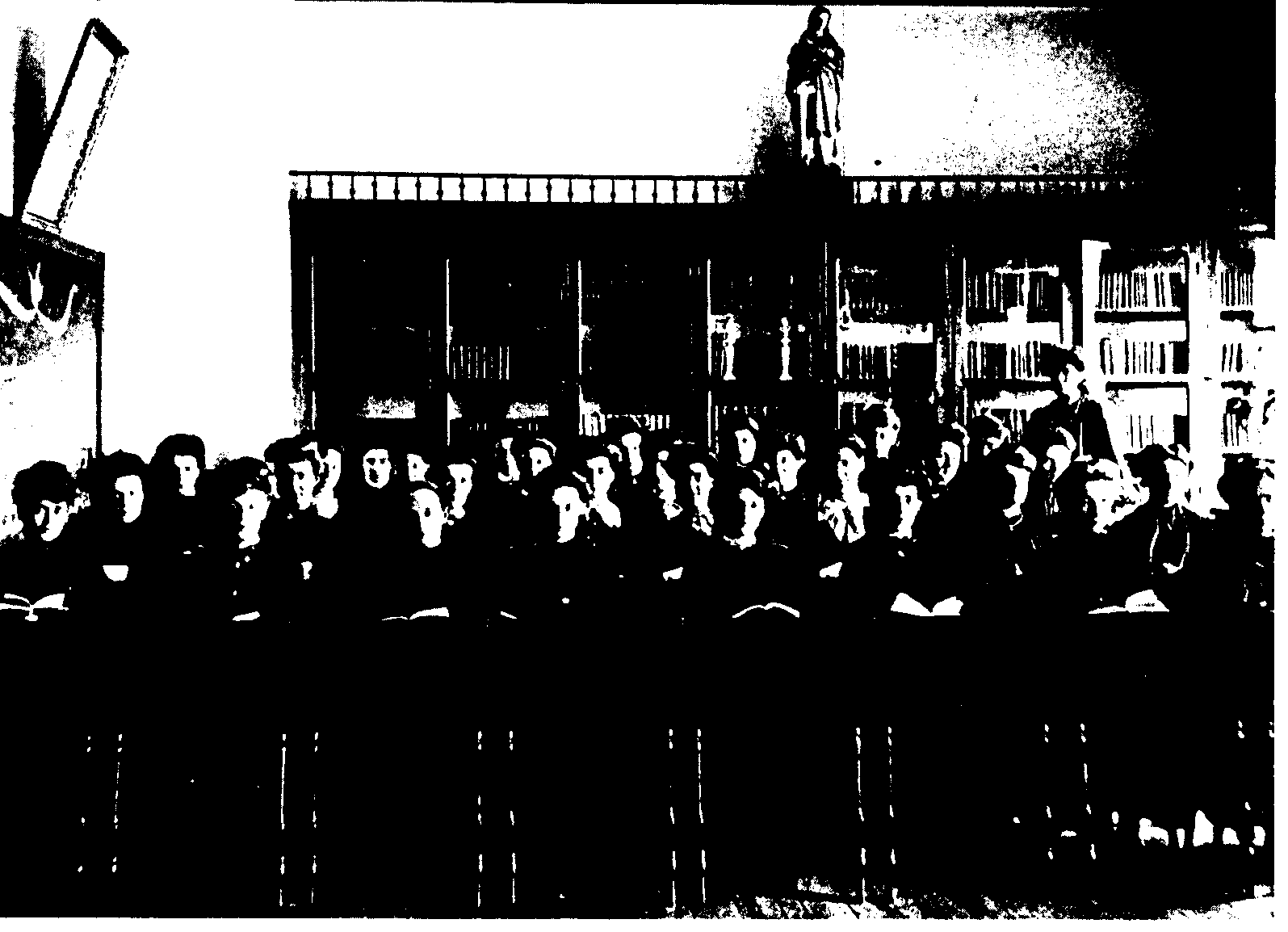
From: Patrick F. Walsh, The History of Antigonish (Antigonish,
1989).
Accompanying womenís greater contributions to campus life was the question of whether or not women should be able to vote in Student Union elections. In the early 1940s, some Mount students began to ask about "getting the vote", however because the Mount was separate from St.F.X with its own student organizations, many students, both women and men, felt that it was not appropriate for women to participate in the St.F.X. elections (Xaverian Weekly, Feb. 13, 27, 1943, March 19, 1949). However, articles in the Xaverian Weekly demonstrate evidence of womenís voting in student council elections, although possibly just in the Mount Saint Bernard elections. It is not clear how much power women had in voting in the St.F.X. student union elections, or if they had any at all, at least up to the mid 1960s, when in 1966 the councils of Mount Saint Bernard and St.F.X were amalgamated (Xaverian Weekly, Jan. 14, 1966, p. 1). Therefore although women had more opportunities, they clearly did not equal those of the male students.
Mount Saint Bernard Dormitory at the Turn of the
Century.
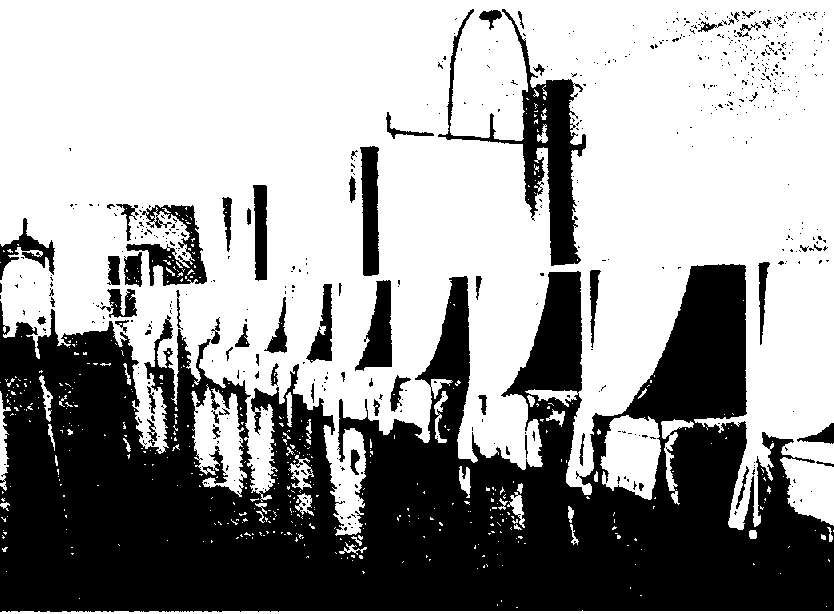
From: Patrick F. Walsh, The History of Antigonish (Antigonish,
1989).
Mount Saint Bernard Girls Going for a Walk to Town.
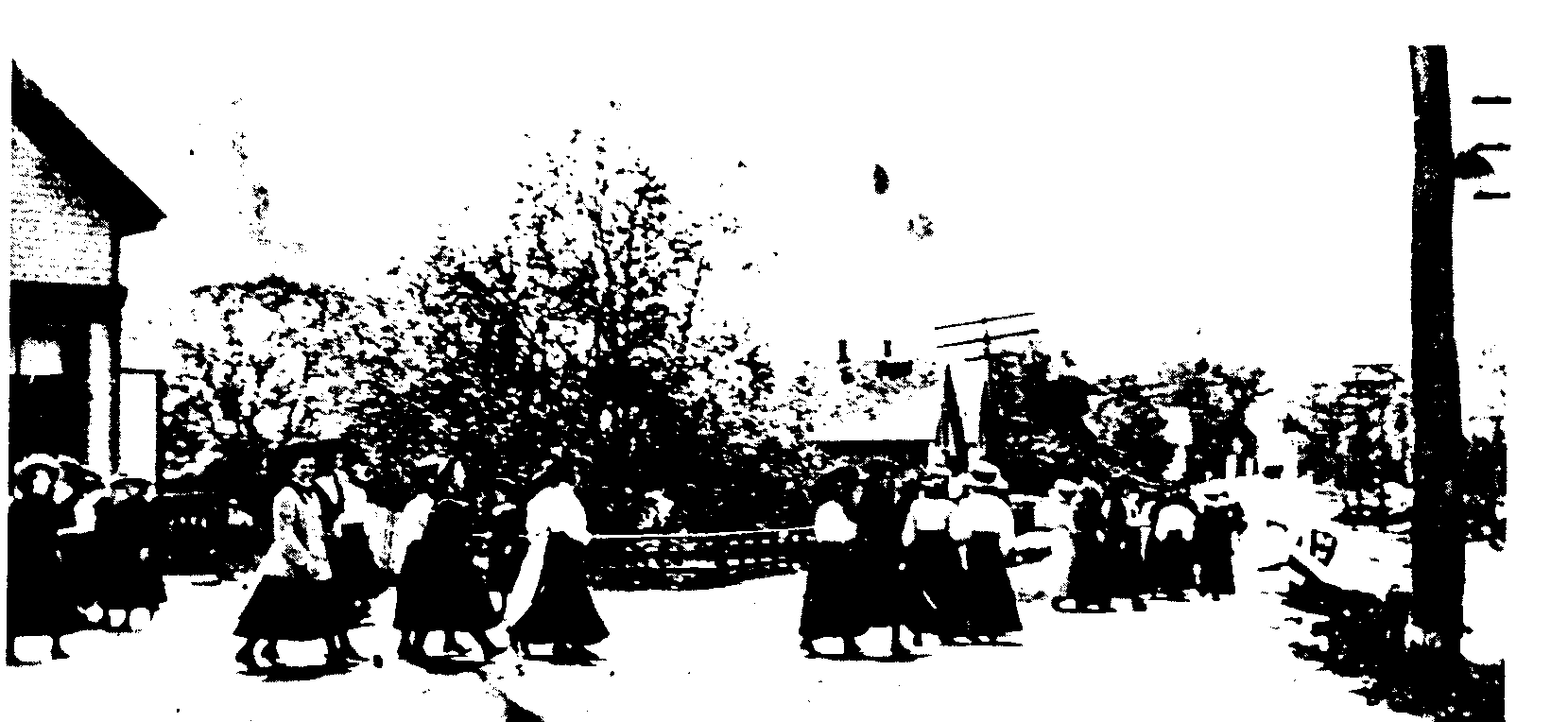
From: Patrick F. Walsh, The History of Antigonish (Antigonish,
1989).
Control over students remained quite strict until the 1960s, when students began to complain of the rules. In 1964 students were allowed to go out on weeknights and there was an extension on weekend curfews (Xaverian Weekly, Nov. 19, 1965, p. 1). In 1968 further concessions were made as students were granted later late permissions, they were allowed to stay out until 1:30 a.m. on Fridays and Saturdays, they were allowed five late permissions (until 2:00 a.m.) per year, they could attend off-campus parties, drive in cars, wear pants, and smoke in their rooms (Xaverian Weekly, Nov. 1, 1968, p. 1). Times were changing.
Rules Change for Mount Saint Bernard Students.

From: Xaverian Weekly, November 1, 1968.
The Marthas went on to establish themselves beyond their involvement
with St.F.X. They eventually became known for their management of the St.
Marthaís Hospital in Antigonish, and their school of nursing, which trained
many young women as nurses.
Sister St. Veronica began the tradition of female professors at
St.F.X. which increased in number in the years following appointment. By
1960 the number of women faculty members increased from one to fourteen,
most of whom were Sisters (Cameron, 324) , and by 1971 they numbered thirty,
18% of the faculty (Cameron, 396). Although the progress was slow, more
women did start to become part of the St.F.X. faculty.
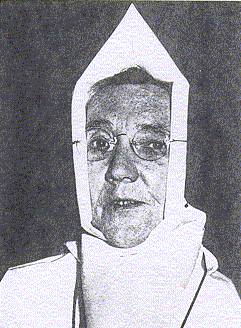
From: James D. Cameron, For the People: A History of Saint Francis Xavier University (Montreal; Kingston, 1996).
Sources Used:
Aims of Mount Saint Bernard
Cameron, James D. For the People: A History of Saint Francis
Xavier University (Montreal; Kingston, 1996).
"Diary of a Home Eccer", Xaverian Weekly, Oct. 24, 1949,
p. 2.
Letter from Sister St. Catherine Martyr, Mount Saint Bernard
Superior, to Fr. P.J. Nicholson, St.F.X. President, 1951
Mount Saint Bernard Centennial 1883-1983.
Mount Saint Bernard Calendar 1894-95 .
Mount Saint Bernard Calendar 1947-48.
Prentice, Alison., Paula Bourne, Gail Cuthbert Brandt, Beth Light,
Wendy Mitchinson, Naomi Black, Canadian Women: A History, (Toronto:
Harcourt, Brace, Javanovich, l996).
Syllabus for "Hygiene and Psychology of Wholesome Personality"
Xaverian Weekly, Oct. 24, 1936, p. 4, 7.
Xaverian Weekly, Feb. 13, 27, 1943, March 19, 1949.
Xaverian Weekly, Jan. 14, 1966, p. 1.
Xaverian Weekly, Nov. 19, 1965, p. 1.
Xaverian Weekly, Nov. 1, 1968, p. 1.
Walsh, Patrick F. The History of Antigonish (Antigonish,
1989).
This page was written and researched by Kristel Fleuren.